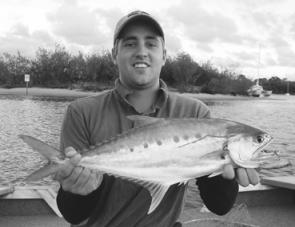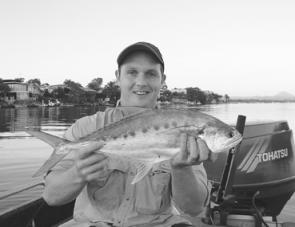So far the pelagic activity in and around Noosa’s Laguna Bay has been rather hit and miss. We can only hope that April shines as the pelagic month of the year.
Historically April has been one of the best months for mackerel and tuna. March has been a beaut month for this type of angling too but my crystal ball was broken when I wrote that column and I cannot guarantee that it’s totally accurate and up to date. We can but try!
It looks as though spotted and school mackerel numbers are on the climb now that many of the pros who chase mackerel have lost some of their netting privileges. Spanish mackerel, northern bluefin tuna, yellowfin tuna and some of the other higher predators should also benefit, in terms of less nets and more food. Current fisheries management practices, in terms of mackerel at least, will certainly help to maintain the fish stocks along the Queensland and northern NSW coastlines for future generations of anglers.
However, all the regulations controlling rec fishers can make things a little difficult for the average Joe Blow. Many anglers don’t understand all the rules, which include regulations such as pectoral fin removal, skin to be left on fillets, fillet length and so on. I don’t know what the answer is, and I applaud DPI&F for at least attempting to put the brakes on the downturn in numbers of some species, but surely there is a better way?
How many anglers, for example, can tell you which whiting species are regulated and how to identify them? Do any anglers fully understand the regulations surrounding tropical snappers and sea perches? What about the exceptions (which are numerous)? Most anglers can open the current regulations booklet and find what they are looking for, but many cannot because it is a complex document. The next bloke booked for non-compliance who was at least attempting to do the right thing won’t be the last!
Super-keen local Peter Morris and his mates Andrew Colefax and Ben Maiden have been honing their skills lately on quality queenfish in the lower reaches of the Noosa system. Pete and his mates generally target these fabulous sportfish early in the morning. They have found the run-out tide to be the most productive phase with poppers and prawn imitations getting the job done.
The lads have enjoyed major success with Owner Gobo poppers, particularly in pale colours. A relatively quick retrieve has been the best bet, as you would expect with queenies. The boys are also catching tailor and trevally on these poppers and seem to be outfishing all others.
Once the sun comes up the boys generally switch to Gladiator prawn lures in gold fleck. These lures can be fished deep and slow or with an erratic stop/start retrieve, and once again they are catching quality fish. It just goes to show that perseverance and experimentation can sometimes produce the goods!
Assuming that the pelagics arrive en masse in March we should see some serious activity in April. Slug casters will do very well and trollers will have some fun, as will cubers. I’ve discussed effective techniques for chasing these fish in recent months so I won’t rehash that topic.
Bottom bashers should also enjoy some quality fishing at close in reefs during April. While the waters surrounding North Reef, Jew Shoal, Halls, Little Halls and Sunshine Reefs will hold good numbers of pelagics feeding on the surface, there will be plenty of bottom dwellers below them. These fish like to collect scraps that sink to the bottom if the birds miss them. The most common catches include squire and snapper, pearl perch, Moses perch, sweetlip, Maori cod and the occasional bonus of coral trout.
Coral trout must be the most sought-after species on Queensland’s reefs due to their first class table quality. They are beautiful fish as well but the bigger specimens are hard to catch due to their trademark dash straight into a coral cave or under a rock as soon as they have taken a bait. Heavy leader is necessary to get them back out again, but even then many fish are lost in this way.
Mangrove jack anglers are still chasing these tough customers in various locations in the Noosa system. Many anglers troll for hours on end, some mix up trolling runs with casting drifts and yet others rely on fresh baits or livies drifted into likely looking snags. Those who put in the time are generally rewarded for their efforts, and this warm weather activity should continue until May or thereabouts.
The endless supply of casting targets in between the major lakes are always worth a try. A slow run-out tide is generally productive, and as the boat drifts along with the current you can make minor adjustments with your electric motor. If you see a big, leafy snag with plenty of sub-surface structure it might even pay to anchor upstream, drift down with the current until you’re adjacent to the snag and thrash the surrounding waters for an hour or so.
Lures that dive quickly will do the job and I must say that bibbed minnows produce well for me. C-Lure Barra Pros in gold chrome with a red and black back have long been my favourite tool for jacks. While it’s easy to stick to an old favourite rather than try other lures, I reckon I’ve done enough research to confidently say that gold/red is a very, very good colour for mangrove jacks!
Flathead, bream, whiting and queenfish round out the estuary happenings for this time of year. The flathead population will generally respond to almost anything on a late afternoon run-out tide. They are gluttonous fish that will eat just about anything that passes their big mouths. Lures, including prawn imitations and soft plastics, will get the job done, as will drifted live or fresh baits. Whole mullet, herring, whiting (legal ones, of course) and flesh strips will all attract flatties, and the chance of bycatch is enormous. Bream, jacks, Moses perch, tarwhine, jewfish, mud crabs and all sorts of other stuff can make unexpected but welcome appearances!
Reads: 3380
Keen local angler Ben Maiden caught this Noosa River queenfish on an Owner popper.

Peter Mossis used a Skitterpop surface lure to trick this Noosa queenfish.




